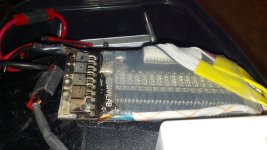joshseitz
100 W
I have a 2.5 year old 48V Ping w/ the 60V 5A charger that shipped with it as an upgrade. Lately it has been behaving erratically. I'll plug it into the pack and it will start charging for 30 seconds or so, then stop for about 10. Today, it charged, then paused, then charged some more, then stopped for good. This happened once before a couple of months ago and I disconnected everything and let it sit for an hour. Upon re-connection all was well. Not so this time.
There are two LEDs on the charger: red indicates that it's powered on, and green indicating that it's charged. The green LED is also illuminated during these periods when charging pauses.
The charger is vertically mounted on my garage wall, with the exhaust fan facing up. It is exposed to some standard garage dust and it can get pretty hit in the garage.
In addition, I have hit LVC on the pack a couple of times in the past couple of months. The first time (and this happened about 2 years ago too), the fets on the BMS got super-hot upon recharge, melting the plastic shrink wrap and generating a ton of heat on every re-charge.
Is it possible that my BMS is causing the charger to think the pack is charged? Should I replace the BMS?
There are two LEDs on the charger: red indicates that it's powered on, and green indicating that it's charged. The green LED is also illuminated during these periods when charging pauses.
The charger is vertically mounted on my garage wall, with the exhaust fan facing up. It is exposed to some standard garage dust and it can get pretty hit in the garage.
In addition, I have hit LVC on the pack a couple of times in the past couple of months. The first time (and this happened about 2 years ago too), the fets on the BMS got super-hot upon recharge, melting the plastic shrink wrap and generating a ton of heat on every re-charge.
Is it possible that my BMS is causing the charger to think the pack is charged? Should I replace the BMS?


